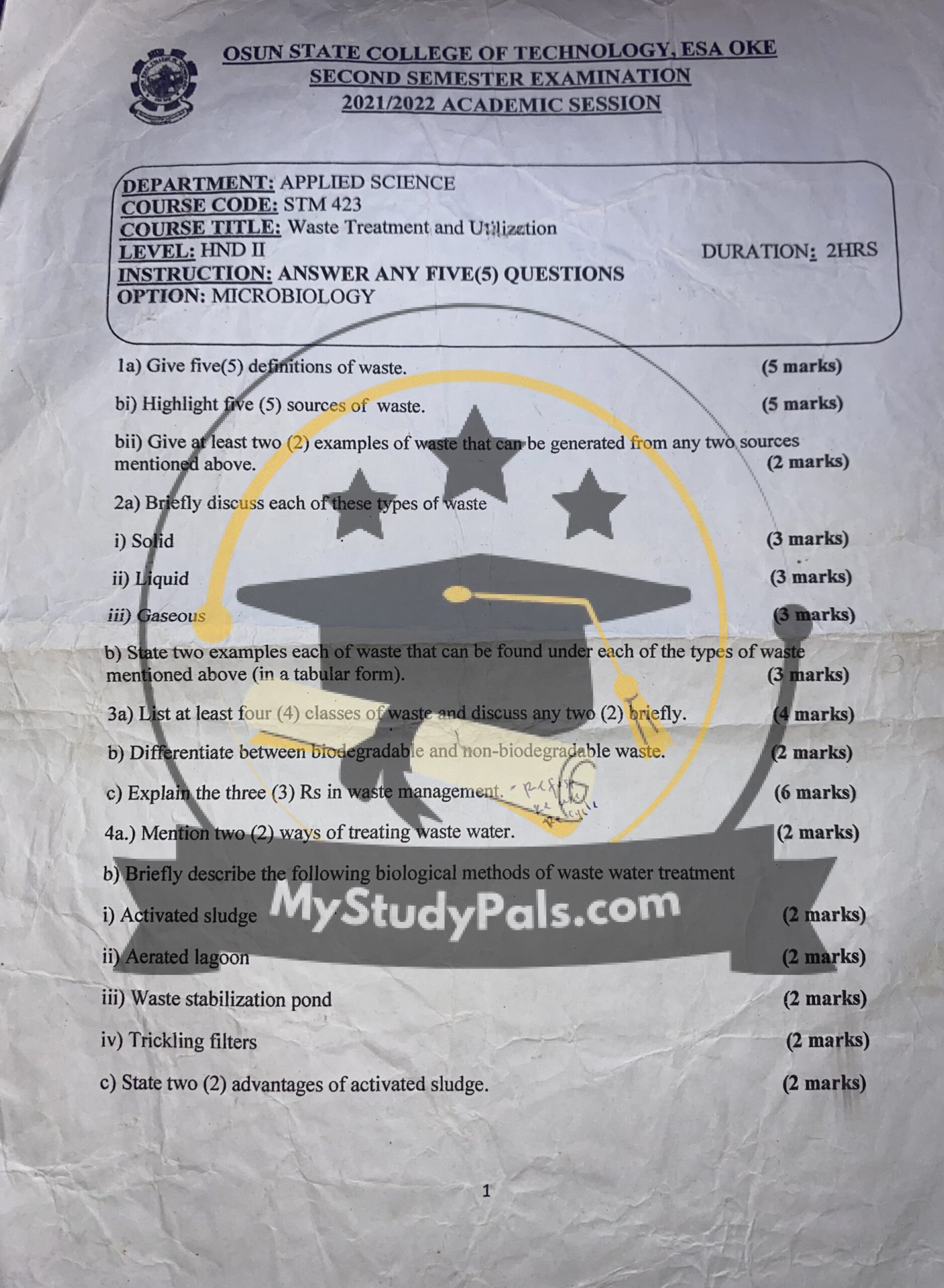ANSWERS
Question 1a:
Five (5) definitions of waste:
-
Waste is any material that is discarded after primary use or is no longer useful.
-
Waste refers to any substance or object that is disposed of, intended to be disposed of, or required to be disposed of by law.
-
Waste is an unwanted or unusable material that results from human activities or industrial processes.
-
Waste includes any by-product or leftover material from manufacturing, consumption, or service activities that has no further use.
-
Waste is any discarded, surplus, obsolete, or broken material that requires disposal or recycling.
Question 1b(i):
Five (5) sources of waste:
-
Household waste (e.g., food scraps, plastics, paper)
-
Industrial waste (e.g., chemicals, metals, manufacturing residues)
-
Agricultural waste (e.g., crop residues, animal manure)
-
Medical waste (e.g., expired medicines, syringes, used bandages)
-
Commercial waste (e.g., packaging materials, office paper, electronic waste)
Question 1b(ii):
Two (2) examples of waste from any two sources:
-
Household waste: Plastic bottles, food waste
-
Industrial waste: Metal scraps, chemical residues
Question 2a:
Brief discussion of types of waste:
i) Solid Waste: Solid materials discarded from homes, industries, and commercial areas, including plastics, paper, and metals.
ii) Liquid Waste: Waste in liquid form, such as sewage, industrial effluents, and wastewater from households.
iii) Gaseous Waste: Waste in the form of gases released into the air from industries, vehicles, and combustion, including carbon dioxide and methane.
Question 2b:
Examples of each waste type:
| Waste Type | Examples |
|---|---|
| Solid | Plastic bottles, paper waste |
| Liquid | Sewage, chemical effluents |
| Gaseous | Carbon dioxide, methane gas |
Question 3a:
Four (4) classes of waste and brief discussion of two:
-
Organic Waste – Biodegradable materials like food scraps and garden waste.
-
Inorganic Waste – Non-biodegradable materials such as plastics and metals.
-
Hazardous Waste – Dangerous substances like chemicals, batteries, and medical waste.
-
E-waste – Discarded electrical and electronic devices.
Brief discussion:
-
Organic Waste: Easily decomposes and can be composted for agricultural use.
-
Hazardous Waste: Requires special handling and disposal due to potential health and environmental risks.
Question 3b:
Difference between biodegradable and non-biodegradable waste:
-
Biodegradable waste: Can be broken down by natural processes (e.g., food waste, paper).
-
Non-biodegradable waste: Cannot decompose easily and remains in the environment for a long time (e.g., plastics, metals).
Question 3c:
Three (3) Rs in waste management:
-
Reduce – Minimizing waste production by consuming less.
-
Reuse – Using items multiple times before disposal.
-
Recycle – Processing used materials into new products.
Question 4a:
Two (2) ways of treating wastewater:
-
Physical treatment (e.g., sedimentation, filtration)
-
Biological treatment (e.g., activated sludge process, trickling filters)
Question 4b:
Brief description of biological methods of wastewater treatment:
i) Activated Sludge: Uses microorganisms to break down organic pollutants in aerated tanks.
ii) Aerated Lagoon: Wastewater is treated in a pond where oxygen is supplied to support microbial degradation.
iii) Waste Stabilization Pond: Large shallow ponds where sunlight, bacteria, and algae treat wastewater naturally.
iv) Trickling Filters: A bed of stones or plastic media is used to allow bacteria to break down organic waste in sewage.
Question 4c:
Two (2) advantages of activated sludge:
-
Efficient removal of organic matter from wastewater.
-
Reduces environmental pollution by breaking down harmful contaminants.


